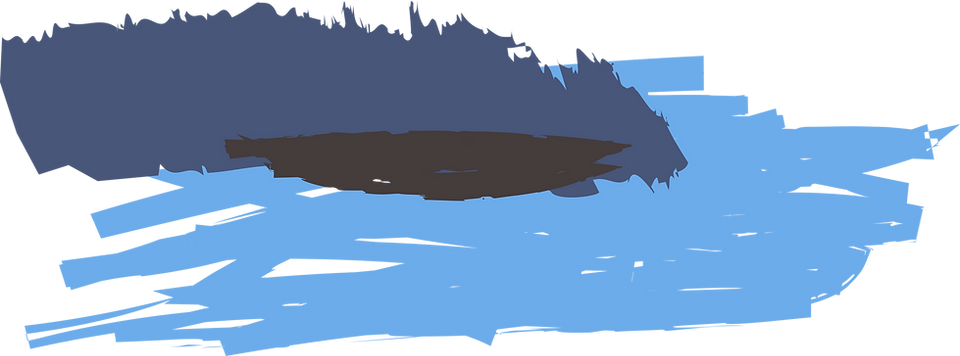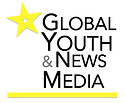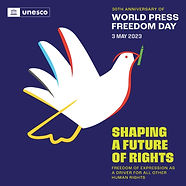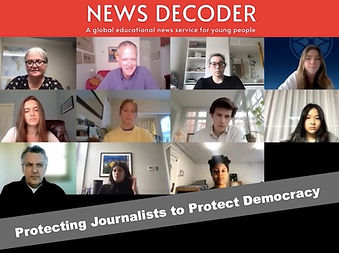

This session, moderated by News Decoder founder Nelson Graves, provides a lively and accessible introduction to the topic. based on students' questions
The 30th anniversary
observance .
put an emphasis on
threats to journalists.

ThReats to journalists
SOME BASIC BACKGROUND INTRODUCTORY RESOURCES

Rappler CEO Maria Ressa of the Philippines, where she faces possible prison and a fine, interviews her attorney Amal Clooney during ceremony for CPJ's Gwen Ifill Press Freedom Award, presented to Clooney in 2020. In 2021, UNESCO named her its laureate for the Guillermo Cano World Press Freedom Prize.
The amount of information about threats to journalists can be overwhelming, and the delivery can be pompous, preachy or both. Here are a few resources that can help offer an accessible introduction.
First, watch these three films
[17 minutes total] Then send the viewers to explore the latests cases on the RSF or CPJ sites. Educator Janis Schachter, a Global Youth & News Media Prize, laureate tells how and why she has her secondary students take it from there.
1. THE WORSENING PICTURE - Reporters Without Borders (RSF) illustrates some extracts of the 2021 edition of its annual World Press Freedom Index report. [00:02:08]. It's a better intro to the topic than more recent videos.
https://www.youtube.com/watch?v=jEb-DvHnvQE
MORE - Each year, RSF ranks 180 countries based on press freedom indicators and offers an analysis of changes.
2. THE PERSONAL FIGHT - Interview of human rights lawyer Amal Clooney by her client, Rappler CEO Maria Ressa of the Philippines (both pictured at the top of this page), who faces nearly constant threats from the government there. Before the interview, the renowned actress and freedom of expression activist Meryl Streep explains why the Committee to Protect Journalists awarded Clooney its Gwen Ifill Press Freedom Award in 2020. [00:09:07] https://www.youtube.com/watch?v=AVb7Fztr7xU
NOTE: In 2021, Ressa received the Nobel Peace Prize along with Dmitry Andreyevich Muratov of Russia, founder and editor-in-chief of Novaya Gazeta. She has since released her new book, How to Stand Up to Dictator, and was acquitted of tax charges against her in early 2023. As of early March 2023, a cyber libel conviction was still under appeal.
More background about Maria Ressa below. Ressa herself has repeatedly taken time -- even during her most pressured moments -- to talk to teachers and students.
3. THE ULTIMATE LOSS - The stories of some of the 21 journalists whose names were the last to be etched onto the Freedom Forum’s Journalists Memorial’s glass panels at the Newseum in Washington DC (now closed) to represent all those who died or were killed in pursuit of the news in 2018. There are more recent collections, but this film offers the kind of compelling coverage that gives a real sense of who these people were. [00:05:00]
Then maybe take Take
an extra nine MINUTES
to watch this
Investigative reporter Ronan Farrow, who is behind the 2022 HBO documentary “Endangered” about the threats journalists face, conducts a calm and matter-of-fact yet chilling interview with Brazilian reporter Patricia Campos Mello.
This short video [00:08:40] provides an experience that is very close to a live, face-to-face encounter thanks to the quality of the conversation and production values.
The link goes to the overall page about the documentary. This video is in the gallery called “The Endangered Tapes” and is free to watch.

If you want to go a bit deeper: THE RESSA CASE
More about the Maria Ressa case. This material form U.S. Public Broadcasting System’s NewsHour EXTRA media literacy series
https://www.pbs.org/newshour/extra/daily-videos/are-press-freedoms-under-threat/
WAN-IFRA produced an interview with her when she won its Golden Pen of Freedom in 2018. UNESCO provided an update about her case when she became the 2021 laureate for the Guillermo Cano World Press Freedom Prize, and the Canadian Commission for UNESCO provided a transcript of her keynote address from its 15 September 2020 webinar on threats to media freedom. A search on "Ressa" and "Nobel" will find further updates about her case that many news organizations provided after she received the Nobel Peace Prize in 2021.


If you want to GO eVEN DEEPER
Trends over time in killing and jailing of journalists and other media workers. Take a look at the "barometer"of the France-based organization, Reporters Sans Frontières / Reporters without Borders https://rsf.org/en/barometer
A full-blown online course. The News Literacy Project (USA) offers a free, interactive 18-part course (under 2 minutes each) from its award-winning Checkology virtual classroom to explore press freedom around the world, narrated by a Germany-based reporter for the USA National Public Radio.
Chapter 1 of a handbook from the Philippines. #MIL4Democracy Handbook takes the rare step of starting with a chapter on freedom of expression, journalism and the threats to both. A team of academics put it together for free download (nearly 10,000 so far).

More about press freedom heroes
WAN-IFRA (the World Association of Newspapers and News Publishers), in recognition of its roots as an organization founded by survivors of the Dutch and French clandestine press of World War II, has awarded a Golden Pen of Freedom since 1961. The Committee to Protect Journalists has done such an award since 1991 and, each year since 1997, UNESCO awards its Guillermo Cano World Press Freedom Prize. It could be interesting to look at CPJ, WAN-IFRA and UNESCO recipients over time to get an idea of the breadth of oppression journalists have faced and then explore what has happened to those laureates since they received recognition.
UNESCO and WAN-IFRA stand among several organizations around the world that document press freedom abuses and honor press freedom heroes. Many are members of the Canada-based consortium, IFEX, The International Freedom of Expression Exchange.
Throughout history, students have been a key force in demanding the release of unjustly imprisoned human rights figures and, in 1996, way before one could launch a social media campaign, played a part in getting Cameroun editor Pius Njawe out of jail. In the next section, there's more about student involvement in press freedom campaigns and courageous reporting.




SOME IDEAS FOR AT SCHOOL
Teenagers Darnella Frazier and Eddy Binford-Ross (pictured at right) each played a journalistic role in the 2020 USA case of the suffocation murder by a police officer of George Floyd and in the demonstrations that followed. Janis Schachter, a former journalist and news literacy teacher at North Port High School (USA), kindly provided Global Youth & News Media with a special set of activities based on those two cases to explore the risks journalists take to get information and to reflect on the importance of that information. More options are below in the form of off-the shelf activity plans.
Janis Schachter was also the silver level recipient of Global Youth & News Media's first Scott C. Schurz Press Freedom Teacher Award in 2021.
Here's a short video [00:03:38] in which she explains how she teaches this topic.

These tweets date from when Darnella Frazier, top photo, received the PEN/Benenson Freedom of Expression Courage Award (12/20) and when Eddy Binford-Ross (lower item) was released from custody (6/20).
MEET A JOURNALIST WHO HAS LIVED IT
Face-to-face encounters with exiled journalists can be very powerful for this topic, even in primary school. In Austria, the media education program of the VOZ national publishers association had a room full of primary school winners of its fun summer puzzle game listen to a panel of exiled journalists explain the press freedom situation in their own countries. A similar project in France sends exiled journalists into countryside classrooms of teenagers. "It is a very boisterous group of students normally," said a teacher whose class had listened to a reporter from Burundi. "I've never seen them so intensively attentive."
France is particularly good at this thanks largely to its Maison des Journalistes that hosts exiled news people, the CLEMI media liaison arm of the education ministry that organizes a nationwide press week with all media and has a rich store of easy-to-use lesson plans, and APEM, the media education provider for most of the country's press.
APEM director Etienne Millien describes the thinking behind this joint effort: "If schools and media companies can team up to explain why freedom of the press is important in democracy, it benefits society as a whole because the voters of tomorrow will understand how to access valuable information and not fall for the seductive illusions of conspiracy theories or advertising. It benefits schools by reinforcing fundamental liberties and media companies by listening to the questions of the young citizens who will shape society in the future." Here is more detail from Etienne Millien about how that works in general and how it worked in 2021.
In countries with no apparent centralized resource center for finding an exiled journalist, students can be assigned to do that search: contacting the local unit of Amnesty International, PEN international, media and journalist groups or other humanitarian organizations.
Through its Project Exile, Index on Censorship has gathered a wide-ranging array of interviews (text) with exiled journalists from all over the world with the help of the University of Missouri's Global Journalist program. Not as good as face-to-face, but offers a start
And don't forget the compelling interviews by reporter Ronan Farrow that HBO provides as free extras on the page about Farrow's documentary "Endangered."
ADAPT OFF-THE-SHELF ACTIVITIES
Off-the-shelf activity plans can be tricky to adapt for local use, especially those from the USA that often lean heavily on that country's very specific First Amendment protections of free speech. However, some organizations in the USA and elsewhere provide material usable most anywhere that press freedom has at least a modicum of support.
Here are a few:
The Pulitzer Center (USA) gathered five of its several hundred lesson plans on the importance of a free media, and how journalists and citizens stand up for it around the world for teachers to use on or around World Press Freedom Day, but the lessons can also be used at any time of year to discuss threats to journalists. For example, the documentary short, Facing Risk [00:06:08] introduces the "potential dangers of international reporting and shows the impact that journalists' career choices can have on their families."
Facing Risk, a mini-documentary and study plan from Pulitzer Center, explores the impact on families of threats to journalists.
Facing History and Ourselves offers When Reporters Are Arrested, an easy to follow lesson plan focused on the imprisonment of two Reuters reporters, Wa Lone and Kyaw Soe Oo, who were covering the Myanmar’s military of genocide against the Rohingya minority there. They were freed 500 days later in a general presidential amnesty. The lesson plan also mentions Wa Lone's book for children, Jay Jay the Journalist, which he wrote while in prison.
WAN-IFRA (global) suggestions for publishers are a bit out of date, but the core ideas remain valid and might spark an inspiration for a slightly different variation for local use.
CLEMI (France, in French) has a very good lessons on explaining the press freedom map produced by Reporters sans Frontières/Reporters without borders and on autocensorship among its extensive ressources pédagogiques (en français).

The Press Uncuffed syllabus and campaign (USA) emerged in 2015 when Washington Post investigative reporter Dana Priest decided to have the students in her "National Security and Press Freedom Reporting" class at the University of Maryland's Philip Merrill College of Journalism try something new. The work, which has students do a deep dive into both country policy and individual cases, aims at university students and lasts a semester, but some elements can also work in secondary school. With the Committee to Protect Journalists, students in 2015 and 2016 did a campaign that sold bracelets engraved with the names of 13 jailed journalists' names to wear until they were released. In that period, seven were released.
The New York Times Learning Network (USA) provides a massive array of news-related activities daily and several competitions for secondary students worldwide. Lesson plans around press freedom include this Lesson of the Day from 2018 that does a good job of encouraging a discussion.

SOME (ALMOST) FINAL WORDs
helping HER students do journalism
BRINGS THREATS to this bolivian TEACHER
Marisabel Bellido Terán, pictured at right, is an educator at Gastón Villa Casso B school on the outskirts of Sucre, Bolivia, where she teaches her students, many of whom are new to urban life, how to write news about problems in their city and reflect on the profession of journalism. She has learned first-hand about the kinds of threats researching a tough story can bring. DETAILS HERE. With thanks to the Foundation for Journalism of Bolivia for providing this information.
She was also the gold level recipient of Global Youth & News Media's first Scott C. Schurz Press Freedom Teacher Award in 2021.
FOR FEMALE JOURNALISTS, DOING THE JOB RISKS VIRULENT ONLINE VIOLENCE
The Chilling, a new UNESCO - International Center for Journalists (ICFJ) report documents dismaying trends in online violence to woman who are journalists around the world. It is important, but not easy reading. The book gives warning that it includes "essential but graphic content that illustrates the severity of online violence against women journalists, including references to sexual violence and gendered profanities."
UNESCO and its partners are also working on awareness campaigns and finding ways to better assure the safety of female journalists

DEPRESSED AFTER
SEEING ALL THIS?
CHECK OUT THIS UPBEAT WAY TO INTRODUCE THE TOPIC
to the very young
Kid Scoop helps children learn about news and build skills in school topics through a weekly page included in about 300 printed newspapers in the USA and Canada. In 2022, it offered its first page to celebrate World Press Freedom Day, including the activity at left, which does a splendid job of introducing the topics of both the need for a free press and the threats to those who assure it. Children choose from the set of words at the top the one that fits each blank lline. To help keep children in that content, there's a find-the-differences element involving the drawings of two boys. That also helps reduce any feeling of being preached to. Well done, Kid Scoop!
Illustration courtesy of Kid Scoop.
All rights reserved
STILL depressed?
Make a happy news
front page
This is one of our favorite activities from The Guardian Foundation (UK), which does superb work through its Education Centre and News Wise programs. The idea of its Happy News Project is simple: look through the day's news, at school or at home, and then create a front page of news that makes you happy.
Illustration at right courtesy of The Guardian Foundation.









![LOGO APEM VDEF sans charte[2].png](png/logo%20apem%20vdef%20sans%20charte%5b2%5d.png)






